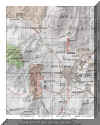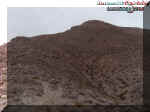|
|
||
|
"This Expedition Is Dedicated To The Pauite Indians Who Lost Their Lands" Lord Rick
When it comes to an exploration often people will ask me why are you risking your life what is the point. Well over the years you start to realize that their are risk in everything you do whether its driving, walking down a stairwell, or even have intercourse in today's society. I set my eyes on the Sheep Mountain Range back in 1994 of course it caught my eye when one morning I woke up seen the peaks covered in white snow. I thought to myself back then wow that seems like one of Las Vegas's highest mountains. In all reality it technically Gass Peak is one of the only peaks in the Vegas Valley that is level with airplanes. When I revisited Las Vegas back in 2004 once again I set my eyes on the mountain of course years ago the area was one of the least frequent visited locations. I had no idea what they called this mountain range not till after my near death experience and one cold night spent in its canyons. Snow Mountain is only part of the range but in all reality I was not up against one mountain but many until I was able to stand just a few hundred feet away from the 7000 foot Gass Peak. I will not be the first man to climb these mountains nor will I be the last but what makes an exploration worthwhile is the photos that are brought back. Many who have climbed these mountains did so in parties, repelling gear, or took this range on from the North Side which is alot easier and less strenuous. It never matters how prepared you are always expect the unexpected. The storms that hit this range are deadly it is the desert roughly a million acres surrounding this mountain range so when you think about it I am merely nothing compared to these earthly monolithic landmarks. From afar the mountain range looks like one giant hill with many cliffs but the reality is that those veins, hills, cliffs etc are the make up of an entire range. Within that range are maze like canyons with many steep walls and obstacles which lead to Gass Peak, Sheep Peak, Snow Peak and a few others. I hear stories about deaths surrounding this mountain some consider myself a lucky man considering I also was a victim of these mountains. As a leader I consider each journey a lesson learned to help teach others safety and educate them to be better explorer's so that what happened to me will not happen to them. It is a sacrifice even the best leaders must make which is putting their own lives on the line. Why climb a mountain? Its simple.....to be able to stand above Las Vegas thousands of feet above is priceless it is something money could never buy. You will never get a view like this anywhere but here therefore my journey is epic and the photos will be enjoyed by thousands of people who visit our site. So many of those people will never make it to the summit so we bring it to you right from your homes. What you will read below is all about the strange solar panels and building on Gass Peak, plane crash in the Sheep Mountains, a tale about hikers who made it to the summit, and history on who Gass Peak was named after. In addition to all of this near the foot hills of the mountain was an area that was mined and quarried. On the opposite side of the range is a location called Fossil Ridge which is rumored to have more dinosaur bones then anywhere in the country. You may read about expedition two and think to yourself Lord Rick is reckless, unprepared, stupid, and unknowledgeable. But before you assume such things keep in mind a few facts. 1. Most people climb to the peak on the north end 2. Most people do not get caught in a storm 3. Most hikers have better gear 4. Most hikers could never do this climb barefoot or with their hands in such temperatures. 5. If you climb it from the North side it takes 2 hours but alas I did not I climbed from the Southside which took around 8 hours very exhausting. These truly are historical achievements on any level you look at it. I consider this expedition one of my greatest I climbed easily a few thousand feet even in the dark cliffs, mountains, steep ravines and made it out to share my story with thousands. It is not because I was stupid or reckless it is because this area is a prominent series of mountain peaks in Nevada. It was never meant for man it was meant for Dinosaurs millions of years ago, Big Horned Sheep, Coyotes, and other desert wildlife. It appears that their are many small caves in this mountain range perhaps the Paiute Tribe used them hundreds of years ago for shelter during snow storms. Some of the oldest barrel cactuses can be found here as well. Its such an untouched area and the Desert National Wildlife Range is the second largest wildlife refuge in the United States so you can understand my need to explore an area. Others have asked me if I would return to the area after two expeditions and the answer is yes if the opportunity does arise I would love to explore other areas or even climb to Gass Peak sometime again. I do not fear these mountains I fear those who dare not to explore them. If you remember many many years ago places like Red Rock Canyon or the Valley Of Fire were really not visited areas because nobody knew much about them. Now today they are state parks designated for hikers, camping, rock climbers and history. I feel one day this area I traversed through will be a very popular hiking area maybe not in this decade but we can actually go on to say that we came, we saw and we conquered. Supposedly other areas near Gass Peak are Gass Springs, Lost Lake, Hidden Forest Cabin, and even Yucca Mountain the supposed nuclear waste storage site. If you were to take the roads behind these mountains you would reach places like Alamo which is not to far away from Groom Lake. Most of the area is part of Nellis Airforce Base which explains the heavy amount of jetfighters that fly right over Gass Peak. As far as the paranormal goes it is hard to say its such a desolate area it could take years of exploring to uncover the strange here. But isn't what important is what is left for the imagination. Our photos from our excursions are alluring and leave you guessing for years to come. Rumor has it that the test flights being done at Area 51 stretch all the way over the Sheep Mountain Range and lets not forget the canyon on the backside is called Dead Mans Canyon:)! Lastly for those that dare venture into the mountain pass please heed my warning this is a very dangerous area to hike at alone. Their is also many cliffs, canyons, ravines, drop offs, low and high temperatures. The winds at Gass Peak can get well over 50mph. Do not try this at home and always make sure you have proper footwear. The only reason why I use less equipment is because we been doing this for a very long time and have experienced survival training. © By Lord Rick Mysterious mountain lights generating power for police A mysterious reflective object that Las Vegans have reported seeing on the mountains north of the city is no mystery to the Metropolitan Police Department. Sgt. William Minor said the department in 1986 installed a solar-powered radio signal tower atop 6,943-foot Gass Peak, at the southern end of the Las Vegas Range. At
various times over the years, a gleam from the solar panels can be seen
from the valley, he said. "Every year since 1986, we've been getting these calls," he said, noting that when it was built, it was the largest public-agency solar-powered radio site in the nation. One observer, Patty Lueken, said she could distinguish six solar panels Tuesday reflecting from the peak while peering through a telescope positioned at the base of Lone Mountain in the northwestern valley. Other observers have said the object, 15 miles from downtown in the Desert National Wildlife Range, appears to move up and down from time to time. Minor explained that the glint from the stationary panels appears to be moving but in reality the people who see it are moving.
Gass
Peak
Review-Journal
Octavius Decatur Gass, 1860s. It was to be the story of his life. Almost at the right place at the right time, but never exactly. Opportunity knocked at his door regularly, but he was always in the bathtub. Gass, born in Richland County, Ohio, in 1827, of Scotch-Irish descent, was driven by the same urges that had sent other young men swarming around Cape Horn to the wild Sierra Nevada foothills of California. He wanted to dig up a fortune, perhaps dabble in politics, and live luxuriously ever after. He arrived in San Francisco already employed. His boss was a clever entrepreneur named Gilman who had filled the ship's holds with portable two-room houses. He reasoned if men were streaming into California by thousands, there was sure to be a housing shortage. He was right. His prefab shacks sold like beer at a horse race. And Gass was hired to unload the houses at a generous wage of $10 per day. Before long, he was headed for the gold fields of El Dorado County, grubstaked, his financial future all but assured. Frustrated
in mining, Gass forsook El Dorado County, Calif., for Eldorado Canyon, in
what was then the newly-created territory of Arizona. The canyon, about 65
miles from Las Vegas on today's roads, was worked periodically for gold,
silver and other minerals, reportedly by Spaniards and Mexicans as early
as the 18th century. By 1863, Gass was staking claims there. One of 90 or
so other miners who worked the area mentioned Gass' zeal to a reporter for
the Los Angeles Star, saying "O.D. Gass is ... the worst struck man
with the prospects here I ever saw." The original settlement had been developed in 1855 by 30 missionaries dispatched from Salt Lake City by Brigham Young. With ample water, reasonably friendly Indians and soil that could support agriculture, the colony survived until 1857, when political infighting among the mission leadership ended the venture. By
1865, O.D. Gass finally learned the lesson that he should have learned
from the man who shipped prefabricated houses to San Francisco. Supplying
boomers and travelers can be as lucrative as wandering around the desert
with a pack mule and a pickax. With the help of Nathaniel Lewis and Lewis
Cole, mining comrades turned ranching partners, he set about restoring and
improving the Mormon Fort. His idea was that it could become a way station
for travelers on the Old Spanish Trail, and supply fresh food to
settlements like those in Eldorado Canyon and along the Muddy River. The
ranch was 640 acres, with Gass holding 160 acres. By 1872, he had bought
out his partners and owned it outright. Gass was still on the lookout for The Big Opportunity, though, and thought he saw it in the embryonic Colorado River town of Callville, in which he invested heavily. He was convinced that steamboats would one day be the chief means of transport to Utah, traveling up from the Gulf of California to the new river port of Callville, where their cargo and passengers would be transferred to wagons. Speaking to the Arizona Miner newspaper, Gass said, "Since it has been fully demonstrated that the Colorado is navigable to Callville, the rapid accumulation of steamers for this trade will astonish the most sanguine." But it was another bad call. The transcontinental railroad provided Utah with easier shipping. Gass served as postmaster for Callville from 1867 until 1869, when even he had to concede that the idea had failed. In 1864, the federal government halved New Mexico Territory and created Arizona Territory. During its first territorial legislature, the new solons created four counties, including Mohave County, the territory's northwest corner. Gass stood for election to the assembly from Callville District. Being one of the few prosperous landowners in the region, he was elected. In 1865, he convinced the legislature to create Pah-Ute County, which included much of Nevada's present Clark County. Callville, still considered an up-and-coming settlement, was named county seat. Gass
excelled at politics, and was regarded as a competent fellow. He had
presence and personality, too, a tall handsome man with a wavy 10-inch
beard and a gentle manner. The Arizona Miner commented, "He is an
active intelligent man and the people of the new county are much his
debtor for the consideration given them by the legislature." There had been Indian trouble along the overland route, so Gass and another legislator, Andrew Smith Gibbons, decided to take a 14-foot boat down the Colorado for 300 miles to Yuma, then go overland to Tucson. When they arrived in Yuma, they discovered that Apaches had killed the regular stage driver, and they were unable to get another coach for a week. But they made it to the session, albeit late, and many others did not. In fact, he and Gibbons were the only legislators from either Mohave or Pah-Ute counties.
In his second session, Gass, was elevated to the upper house of the
legislature, the council, elected Spanish-language translator and
interpreter, and chaired a joint committee on military and Indian affairs. On May 5, 1866, at the urging of Nevada Sens. James W. Nye and William M. Stewart and Rep. Delos R. Ashley, Congress made Pah-Ute County part of Lincoln County, Nevada. Gass was as upset as the rest of the Arizona legislature, and blasted the bill as "the Nevada project of stealing us from Arizona." In fact, he ignored the legislation, and continued to represent Pah-Ute County in the Arizona Territorial Legislature until 1869. Gass and his Las Vegas Valley neighbors even asked the Nevada legislature to clip off the point of Lincoln County and create a Las Vegas County. No action was taken. It was at this point that Gass began to experience real financial trouble. Nevada was demanding two years' back taxes from him. Many Mormons in the Muddy River country -- some of his best customers -- refused to pay Nevada taxes and moved back to Utah. And, with about 600 constituents gone, and a government centered in the north, Gass lost his political power, although he did serve as a Lincoln County justice of the peace. Love finally came to the Gass Ranch in 1872, when Gass married Mary Virginia Simpson, a niece of Ulysses S. Grant. Simpson had come West in 1871 with her sister and brother-in-law and settled in St. Thomas. Gass courted her for the better part of a year, making trips by buckboard 60 miles through the desert, before she gave her consent. Mary Gass settled into the ranch life well, and produced six children. Gass generally regarded the indigenous Paiutes as a nuisance -- except, of course for those he hired to work for him. However, he and his wife did take the trouble to learn their language, and there were few instances of outright hostility, owing to Gass' reputation for fairness. The Paiutes called him "Pe-No-Kab" meaning "long back", referring to his broad shoulders. But there were occasional incidents. One of the more terrifying came in 1878, when word came to the ranch that a war party of Mojaves were coming into the valley to engage their old foes, the Paiutes. Gass immediately loaded his family, which included two children with whooping cough and a pregnant wife, into a wagon and made a 40-mile dash for Ivanpah, Calif., where the family lodged with friends. As a Lincoln County justice of the peace, he was called upon to preside over a case in which one Paiute shot another. The suspect was brought before Gass, along with witnesses. Gass, knowing that any judgment would bring trouble from one Paiute faction or the other, announced that everyone should adjourn to the ranch house for dinner. He left one Indian to guard the prisoner. As they dined, a gunshot was heard. Everyone ran outside, to discover the defendant dead, and the guard standing with a smoking gun. He had tried to escape, the guard explained. Gass was surprisingly calm about the incident. He was even less concerned with the Indians' threatened insurrection. A half-breed had managed to convince a few of his colleagues that Gass was cheating them, and owed them better compensation. He and two armed warriors went to the ranch house to demand their due. Gass, however, had heard of the potential problem, and had piled all his firearms on the big kitchen table. When the delegation arrived, he invited them to come in. That was the cue for Lee, the cook, to ring the big triangle that normally summoned the hands to dinner.
"You hear that?" he asked the leader. "There will be men to
get these guns and you won't be able to get anywhere." By the age of 50, Gass had all the trappings of a successful rancher. He owned 960 acres, employed more than 30 hired men, including a veterinarian, blacksmith, barnkeeper, carpenter, several Indian women to handle laundry, and Lee the cook. But
he was heavily in debt, and had been attempting to sell "The Las
Vegas Rancho" since 1868. Unable to do so, he had mortgaged it in
1874 to a neighbor, William Knapp, for $3,000. He went to California in
1876 to obtain bullion to pay Knapp off. In 1879, he borrowed $5,000 in
gold at 2.5 percent interest from Archibald Stewart, a prosperous rancher
who operated a place north of Pioche. Gass had expected a bumper crop to
pay off the debt, but bad weather destroyed much of it, and Gass found
himself in default. Stewart foreclosed, and Gass was out of the ranching
business. Another concern, one he shared with his wife, was the lack of education for their children. He left the ranch in 1881 with his family, personal possessions, and 1,500 head of cattle. They stopped first in Pomona, Calif., then tried unsuccessfully to raise grapes in the Yucaipa Valley. His mining fever never cooled, though, and he continued to prospect, going as far south as Baja California. In 1900 and in his 70s, Gass finally joined his son, Fenton, in Bryn Mawr, near Redlands, Calif., where he tended a small garden and helped in the orange groves. He died after a fall on Dec. 10, 1924, and was buried in the Masonic Plot at the Hillside Cemetery in Redlands. Ironically, the man who first settled Las Vegas is memorialized only in a downtown street that bears his name. And it is probably just as well. He really never cared very much for Nevada, anyway.
By
GLENN PUIT REVIEW-JOURNAL
Photo Above Was Taken In 2004 By Lord Rick On A Visit To Las Vegas
NLV
police call two deaths a probable murder-suicide
A Powwow at Snow Mountain's Base just westward of where I Hiked At
|
||
|
society, Mib, conspiracy, time travel, specters, Armageddon, prophets, prophecy, paranormal, ghosts, aliens, Buffalo, haunted houses, cryptozoology, dimensions, apocalypse, Atlantis, curses, monsters, wildman, yeti, cemetery, stigmata, vampyre, vampires, angels, bizarre, metaphysics, Atlanta, Louisiana, Myrtle Beach, planet x, mothman, jersey devil, apparitions, werewolf, werewolves, devils, vortexes, Bermuda triangle, lycanthropes, mystery, ancient, spirits, cydona, mythology, Charlotte, Atlanta, Mobile, possession, possess, mailing list, parapsychology, poltergeist, evp, investigation, crop circles, Roswell, abduction, project blue book, living dinosaurs, religious miracles, ny, sightings, north Carolina, south, brown mountain, cleansing, shadowmen, beast, ogopogo, death, portals, spontaneous human combustion, zombies, ouija boards, nostradamus, Edgar Cayce, art bell, George Nooray, Magick, Paganism, Wicca, Tennessee, Halloween, bigfoot, Sasquatch, ufo, grays, ufos, vortexes, alien, hybrids, Haunting's, demons, demonology, occult, mystics, lochness, chupacabras, equipment, Thermal, EMF, Cassadaga, energy, asteroid, civil war, spooky, scary, adventure, ectoplasm, orbs, graveyards, demons, spirits, cults, buffalo, new York, ghost society, logo wear, equipment, books, videos, music, certification, Castles, Forts, fortean, phenomena, nonprofit, business, investigations, SPH, EMF, ghosthunting, organization, conventions, hollow earth, paranormal & ghost Society, detector, posters, mailboxes, donate, Buffalo, xfiles, Ectoplasm, magik, spells, wicca, paganism, holy, cross, NWO, Patriot, 911, September 11th, tours, cryptid, ghostlights, dinosaurs, Florida, Fl, Daytona Beach, Jacksonville, St. Augustine, Debary, Miami, Tampa bay, Sarasota, Pensacola, NASA, Cape Canaveral, Space Coast, space shuttle, gulf breeze, key west, Sanford, port orange, Ormond beach, New Smyrna, Orlando, Disney world, Tallahassee, Stetson university, panama city, Alabama, Georgia, Savannah, New Orleans, Cocoa Beach, Ocala, plantations, Fort Lauderdale, Melbourne, Naples, Lake Wales, grim reaper, everglades, Seminoles, big cats, Fort Myers, St. Petersburg, Lakeland, Gainesville, West Palm Beach, bike week, spring break, Deland, Deltona, Orange City, weird, strange, bizarre, mysterious, rituals, skunk ape, adventure, ships, ghost pirates, ball lightning, x-files, conspiracies, Las Vegas, California, Nevada, wild west, Mojave, Navajo, timucuans, Seneca's, Iroquois, Cult, Occult, Indians, Historical, Bands, Gothic, New Age, Spiritualism, Parapsychology, CA, California, youtube, media, hard rock, heavy metal, Portal, 666, demons, fallen angels, gods, CA, Reno, Las Vegas, Sacramento, San Francisco, Roseville, Woodland, Davis, Los Angeles, Oakland, San Jose, Lodi, Napa, Vallejo, San Andreas, Modesto, Tahoe, Santa Rosa, Redding, Yuba City, San Diego, Eureka, Chico, Fresno, Salinas, Stockton, Oxnard, Auburn, Fairfield, Vacaville, NV, Carson City, Nevada, Eldorado, Yosemite, Merced, Hollywood, Eugene, Oregon, Salem, Portland, Bend, Boise, Salt Lake City, Seattle, Washington, AZ, Phoenix, Native American Folklore, Beatty, NV, Sin City, Mines, Bakersfield, Fresno, Jackson, San Andreas, Sutter Creek, Folsom Lake, Citrus Heights, Redding, Sierra Nevada's, Foothills, Spaniards, Savannah, Kinzua, Hoover Dam, Henderson, 420, Marijuana, weed, pot, joint, science, caves, spelunking, stunts, extreme, desert, woods, swamps, caving, tunnels, catacombs, UE, Urban exploration, abandonment's, video, movies, production, new age, ambient, techno, Satanism, convention, conferences, thermal detector, digital recorder, d5, deggi5, abandoned, trespass, trespassing, death, druid, curse, cursed, Chumash,Hupa ,Mission, Nez Pace, Pajute, Pomo, Salish, Ute, Creek, Cherokee, Chickasaw, Pueblo, Hopi, Anasazi, Apache, sonora, placerville, folsom lake, sin city |
|
























